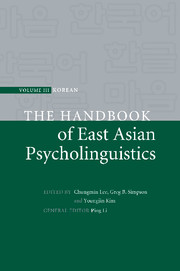Preface
Published online by Cambridge University Press: 05 June 2012
Summary
This is the third and last volume of the three-companion-volume series on East Asian psycholinguistics. East Asian here includes Chinese, Japanese and Korean, the languages that have received increasing interest in psycholinguistic research beyond the Indo-European languages. The three languages reveal extremely interesting typological characteristics; Japanese and Korean are strikingly similar in structure and various other respects, although they show surprisingly important and subtle differences. Chinese, on the other hand, contrasts more sharply with Japanese and Korean in typological patterns, although the three share certain areal commonalities such as the use of numeral classifiers. Korean and Japanese are similar grammatically, but not lexically and phonologically. Because of many commonalities in grammar, the two languages are often compared and contrasted linguistically and psycholinguistically (see Japanese/Korean Linguistics 1 to 15, CSLI, among others). Korean is generally hypothesized to belong to the Altaic language family, which encompasses Manchu-Tungusic, Mongolian, and Turkic languages. Japanese is also often believed to be an Altaic language, whereas Chinese belongs to the Sino-Tibetan language family. Korean and Japanese are thus distinct from Chinese genetically and typologically. However, the two languages have a vast amount of culturally borrowed Sino-Korean and Sino-Japanese lexical items, respectively, even adopting Chinese characters minimally in Korean and vastly in Japanese in their writing systems.
Therefore, the idea of the trio in companion volumes is crucial for comparative studies, not only among the three but also between the three and other languages including English.
- Type
- Chapter
- Information
- The Handbook of East Asian Psycholinguistics , pp. xix - xxPublisher: Cambridge University PressPrint publication year: 2009



